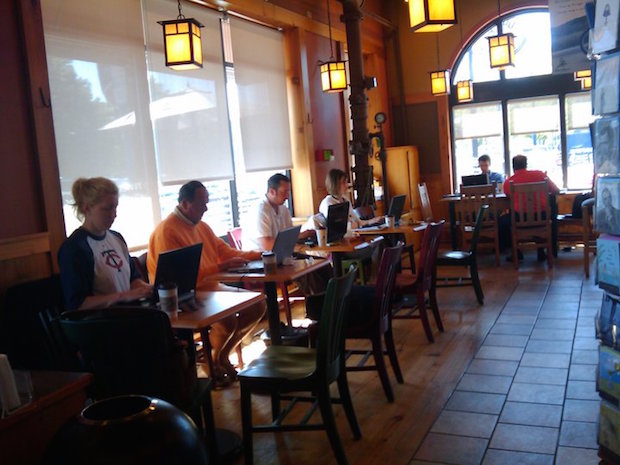As we draw towards the close of 2014 and look ahead to a new year, it’s a time of reflection, evaluation, and goal setting for many people. Performance reviews (if you’re still doing it the old way), finalizing budgets, and making plans for the next 357 days (until the holiday season rolls around again) are squeezed in on top of normal work and projects with end of year deadlines.
While most organizations are locked into benchmarking off of last year’s success to set next year’s goals, a more important question may be looming. Hold that thought for a minute and join me for a quick coffee break.
The other day, I walked into Starbucks. I had an hour or so in between meetings, so I had my laptop with me. After I ordered my coffee and sat down, I was amazed to see that one guy had actually brought in his 21.5″ iMac… into Starbucks…a “coffee shop”. What would have happened if there were no power outlets available?
Over the past year (seemingly an acceleration of a multi-year trend), I’ve witnessed a steadily growing army of laptop-focused mobile workers in restaurants and coffee shops who post up for hours; working, while paying their rent by purchasing a cup of coffee. Often, it’s even hard to find a place to sit. This reality has even caused some coffee shops to strike back against what’s come to be known as coffee squatters.
Observing these changes begs the question “What business is Starbucks in”? The quick and easy answer is selling coffee, even though it continues to expand its food offerings, and even wine and beer. Surely, August First aligns with that belief. But is that really it? And will that be true five years from now?
Hoover’s lists Starbucks top competitors as McDonalds, and Dunkin’ Donuts. Traditionally, that’s true.
What I increasingly wonder about Starbucks traditional coffee business is:
– How much revenue comes from serving the traditional caffeine (and extended food and beverage) wants and needs?
– How much revenue comes from “pay rent” for a place to work for a mobile workforce?
More importantly, is there opportunity for Starbucks (or others) to define a new niche somewhere between the growing executive office/work sharing spaces and the coffee shop workers? Is there a startup out there that can provide a better experience for what people are really looking for?
As an aside, it’s also interesting to note that earlier this year Howard Shultz said that he believed there was a chance that they’d be able to license their software and technology for profit.
What business is Starbucks in?
Adaption, re-assessing, and reimagining is something familiar at Starbucks. As most of you know, Starbucks was once just one store selling coffee beans and expresso machines, until Schultz went to Italy, and came back enthused to open up European style coffee houses, birthing the Starbucks we all know today.
Thanks for the coffee break. Now back to that question. But don’t forget about what we’ve discussed here.
What Business are you in?
What business are you in? It seems like a simple question with a pretty straightforward answer. Most organizations believe they can clearly articulate what business they are in.
We’re an industrial manufacturer.
We’re a bank.
We’re a retailer.
Theodore Levitt, one of the early pioneers in customer focused thought leadership, began to revolutionize management thinking in 1960 by asking this question in a new way. It’s a question that when answered wrong can lead to the demise of organizations or entire industries.
In 1910 innovative and successful White Star and Cunard shipping lines got it wrong when they assumed that they were in the transatlantic shipping business. They were actually in the transatlantic transportation business, that would soon be dominated by the airline industry. That slight misstep caused them to fade away over the next few decades as the airline industry took off.
Consider how the railroads also assumed that they were in the railroad industry, instead of the transportation business. They missed dozens of opportunities as other means of transportation evolved and exploded all around them.
Sticking with the transportation theme, today we are witnessing Uber threaten both the “taxi” business and arguably the auto manufacturing business by focusing on the core jobs that people are trying to do. They realized that people don’t really care about taxis. They just care about safe, reliable, frictionless transportation. No doubt that others will gain a deeper understanding of human needs and will leverage yet to be developed technology to meet customer transportation needs better in the future. In fact, I had a chance to speak to Customer Experience leaders from most major auto manufacturers several weeks ago. But that’s a conversation for another day.
Why are we discussing 50 year old management thinking?
The first answer is that I see over and over again that many executives continue to make the same mistake. This is not because executives are dumb and misguided. The vast majority have been successful because of their ability to execute. It is this excellence in execution that has led to success. Successful execution requires extreme focus, passion, and energy to make something work. Success, by it’s very nature breeds inertia to continue to do what’s worked in the past. The problem is that the evolution that used to happen in markets over a period of 20 years (like what happened to the shipping lines) now happens in 2 or 3 years.
We saw what happened to Kodak, who was one of the earliest pioneers of digital photography. They missed what business they were really in, and failed to recognize the power and trajectory of emerging technology to overtake them. They misunderstood that consumers didn’t really care about the medium. They really wanted memories instantly, clearly, and cheaply. Film died. And so did Kodak to a technology that they helped to invent.
The digitization of everything is disrupting nearly every industry and forcing senior leaders to re-evaluate what business they’re truly in, more often. The truths that Levitt espoused are still true. However, we don’t have 20 years to wake up and understand. We have 2.
So, how does this play out today?
In recent history, we’ve seen tech startups model for us what the new pace looks like. Odeo was a struggling platform designed to help people create and share podcasts. The founders sold it off in favor of a new short hand communication tool called Twttr. Just a couple years later, the renamed and rebranded Twitter was a global phenomenon with a valuation in the billions of dollars. Odeo went on its own journey of acquiring other companies, and relaunching and evolving to serve the needs of corporate clients. Same narrative. Different story.
Arguably the most successful social network of the moment, Instagram, was originally launched as Burbn, a location based app that also had a photo element. After evaluating what they had, the founders stripped everything else away and focused on the photo sharing piece. The rest is well…
In both cases, it was the side feature that became the real business. It reminds me of how Wrigley used to throw in free chewing gum to help sales of baking powder. When the gum became more popular than the baking powder, he pursued the new business.
What business am I in?
The landscape is littered with stories of organizations reframing their view of the market, understanding customer needs, and focusing on enabling outcomes with new technologies and capabilities. Unfortunately, it’s also flooded with myriads more that did not.
Google knows this well and is increasingly penetrating spaces worlds apart from the perceived domain of search engines (GPS systems, wind energy, driverless cars, cancer research, etc.)
Professional services firms are wrapping their IP into products and becoming software vendors. As is Nike (the world’s best known footwear manufacturer).
The transition to a world where we’ll no longer feel the need to differentiate between physical and digital has removed (and will continue to remove) many of the barriers to pursuing new or adjacent market spaces. Companies can be started and new products can be launched with hundreds of dollars, not hundreds of thousands. The entire Venture Capital industry has been reshaped to place lots of small bets. Incubators help cultivate lots of ideas that are able to release a minimum viable product into the market, get feedback, improve, pivot, grow, or shut down, and move on to the next thing with less money and less time.
We see a similar trend in enterprise applications. Evolving use cases and increased capabilities are on a trajectory towards creating more and more “disposable apps“. The costs to create, distribute, and use new applications has become so low, that applications can often be created, utilized, and discarded in shorter time windows than it used to take to simply spec a product. They are less reliant on huge capital investments. They are (or are moving towards) disposable.
In this vein, there’s also an argument for a similar concept being applied towards business models in general. We may be entering an era of not just disposable apps, but perhaps disposable business models, where the lifetime of the model, the consistency of the inputs, and the viability and demands of marketplace will continue to operate in ever shortening windows. Imagine the amazing and varied history of GE, HP, Texas Instruments, or IKEA all sandwiched into a decade, instead of a century.
Sensors, wearables, mobile computing, artificial intelligence, combined with the rapid descent of storage, processing power, and bandwidth costs towards free continue to reframe what’s possible.
Persistent reframing, leveraging of emerging technology, and aligning new capabilities to reach core customer needs is required to succeed in tomorrow’s world. The imperative of the day is to reimagine and retool, while building the proper infrastructure to scale quickly. These are age old challenges merged with unprecedented access to new tools and a marketplace on speed. Complicating matters further is that this reframing, reimagining, and retooling most often has to be done in parallel with existing core operations.
The key is not to draw specific conclusions or emulate exact strategies from each of the examples above, but rather to consider how to institutionalize the process of asking “what business are we in?” while creating the boldness and agility within the organization to consistently align emerging capabilities and offerings to shifting marketplace demands. The digitization of everything will continue to unveil unprecedented access to power that will both open up new opportunities and threaten your current business. How will you respond?
What business are you in? Today? Tomorrow? 3 Years from Now?
This post is brought to you by InnovateThink and Cisco.





